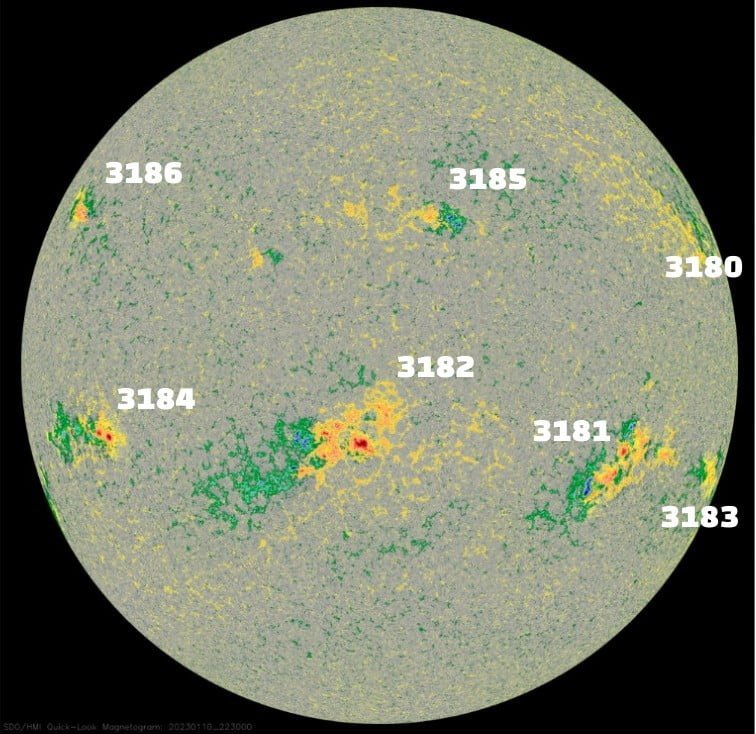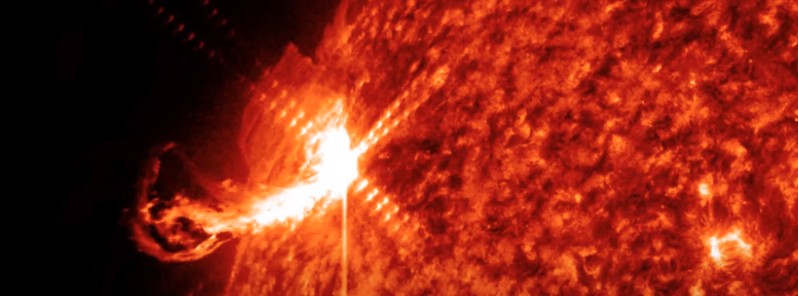Solar activity is expected to remain moderate through January 13, with the continuing likelihood of M-class flares (70%) and a chance of X-class events (30%) due primarily to the combined flare probabilities of Regions 3181, 3182, 3184, and 3186. A total of 3 X-class solar flares erupted since January 6, including X2.2 — the second strongest solar flare of Solar Cycle 25.
Solar activity reached high levels in 24 hours to 00:30 UTC on January 11, 2023, following an impulsive X1/2b flare — the third X-class solar flare since January 61 — from Region 3186 (beta-delta) which was the most active region during the period and the source of an M5/Sf (R2-Moderate) flare at 00:16 UTC on January 10, an M1.3 flare at 17:28 UTC, and multiple C-class flares.
The region appeared to possess a delta configuration from likely mixed polarity umbrae within the leader penumbral area.2
Additionally, Region 3181 (beta-gamma) grew in coverage and spread in heliographic extent and produced a few M-class flares.
Region 3182 (beta-gamma-delta) — the source of the X1.2 solar flare on January 6 — weakened but retained its bipolar configuration, mainly producing optical subflares.3
Region 3184 (beta-delta) rotated further into view and despite some foreshortening, produced a few M-class flares. This was the source of the X1.9 solar flare on January 9.4
New Region 3187 (alpha) was assigned, but the region was inactive while Region 3185 (beta) produced a C5.3 flare.
The remaining regions changed little or underwent some decay.
No Earth-directed CMEs were observed in available coronagraph imagery.

Solar activity is likely to remain moderate through January 13, with the continuing likelihood of M-class flares (70%) and a chance of X-class events (30%) due primarily to the combined flare probabilities of Regions 3181, 3182, 3184, and 3186.
The greater than 2 MeV electron flux reached moderate levels during the period and is expected to be normal to moderate through January 13. The greater than 10 MeV proton flux is expected to remain at background levels, with a slight chance of an S1 -Minor solar radiation storm due to the combined solar energetic proton event potential of the several large sunspot group complexes present.
Solar wind parameters were indicative of a minor disturbance in the IMF and slight escalation in solar wind speed, likely due to proximity to an anticipated coronal hole high speed stream (CH HSS). Disturbances and enhancements in the solar wind field are likely to continue on January 11 due to effects from proximity to or weak connection with an isolated, negative polarity CH HSS. Any influences are anticipated to wane on January 12 and a return to a more ambient-like state is expected on January 13.
The geomagnetic field was at quiet to unsettled levels in response to the mildly enhanced and disturbed solar wind field, and the same conditions are expected to continue through January 11, with a return to mainly quiet levels on January 12 and 13.
1 X1.0 solar flare erupts from Region 3186 — CME produced – The Watchers – January 11, 2023
2 Forecast Discussion – Issued: 2023 Jan 11 0030 UTC (corrected version) – Prepared by the U.S. Dept. of Commerce, NOAA, Space Weather Prediction Center
3 X1.2 solar flare erupts from Active Region 3182 – The Watchers – January 6, 2023
4 Major X1.9 solar flare erupts from Region 3184 – The Watchers – January 9, 2023




